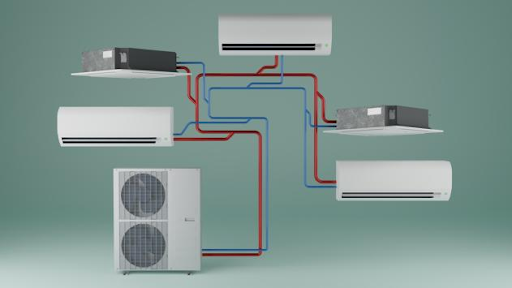
Size
In contrast to residential HVAC systems (unless we are talking about Bill Gates’ house), commercial HVAC systems must condition and ventilate larger and more complex structures. The assumption is that commercial systems are a higher capacity.
You are correct that the components are larger. The residential system is comprised of a single unit, whereas the commercial system is modular. Installation and maintenance of a commercial system are much easier since its components are all located nearby. Residential air conditioners can be up to five tons here in the US. Rooftop modular units often range from 10 to 50 tons. Among the many new additions to the HVAC system, there are new thermostats, condenser fans, compressors, evaporators, blowers, and dampers.
Location
An indoor heating system, like a furnace, can be located in the basement, the closet, or the attic in a house, and the outdoor unit can be found in the backyard or on the side of the house. It is called a split system. However, in commercial buildings, HVAC systems are usually located in a utility room, either in the basement or adjacent to the building, and quite often on the roof. Packaged HVAC systems provide all the required features in a single package. In addition to providing a good noise barrier, the rooftop is spacious and out of the way.
Economizers
The best kept secret of commercial HVAC may just be these. By using logic controllers and sensors, they remove heat from buildings by bringing in cool outside air. This system is essentially a free form of cooling for buildings. You will experience a reduction in energy consumption, less wear and tear on your HVAC system, and better ventilation. Especially for older buildings, which may not benefit from modern HVAC systems, the latter is of particular importance. Residential HVAC systems do not have economizers.
Zones
While commercial HVAC systems are typically standalone units with their own thermostats, residential HVAC systems typically use packaged units. This allows for a wide range of indoor climates in one building. Individual areas can be controlled independently from each other. Repairs can be performed in each area separately so that no disruption occurs.
Ventilation
In a commercial building, ventilation is more complicated because of its larger size. Smaller residential buildings have a greater number of windows per square footage, so keeping them open is a great way to keep stale air at bay. A mechanical ventilation system or fresh air intake system is generally required for commercial buildings.
As well as restaurants, fitness areas, laboratories, and other commercial facilities requiring adequate ventilation, commercial buildings also typically include other facilities which require good ventilation for good indoor air quality.
Drainage
During the heating or cooling process, HVAC systems remove humidity from the air. The moisture drips into the tray during this process. Generally, the main difference between a commercial system and a residential system is that a commercial system will have a more complex network of pipes and drains.
Cost
Brand, type of HVAC system, size of building, type of business activity, installation costs, etc., impact the cost of commercial HVAC systems. Knapp Schmidt Architect estimates that small businesses with one cooling zone may spend between $3.50 and $4 per square foot on an air conditioning system, while larger businesses may pay between $7.50 and $10.50 per square foot.
Maintenance
In most cases, it is more expensive to fix a commercial system than it is to repair a residential system. HVAC equipment designed for commercial use requires specialized tools and specialized expertise. HVAC equipment designed for commercial use is often located in difficult to access areas and requires specialized tools. HVAC maintenance for commercial buildings also costs more, since technicians must make more frequent visits.
In addition to a monthly filter change, many business owners highly recommend a full scope maintenance visit each quarter instead of two yearly visits.
(Yes, we can help with that).
It doesn’t end there. There are unique problems associated with commercial HVAC systems.

Leave a Reply